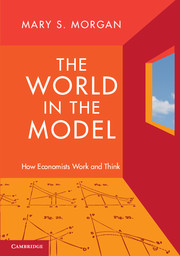Book contents
- Frontmatter
- Contents
- Figures, Tables, and Boxes
- Preface
- 1 Modelling as a Method of Enquiry
- 2 Model-Making: New Recipes, Ingredients, and Integration
- 3 Imagining and Imaging: Creating a New Model World
- 4 Character Making: Ideal Types, Idealization, and the Art of Caricature
- 5 Metaphors and Analogies: Choosing the World of the Model
- 6 Questions and Stories: Capturing the Heart of Matters
- 7 Model Experiments?
- 8 Simulation: Bringing a Microscope into Economics
- 9 Model Situations, Typical Cases, and Exemplary Narratives
- 10 From the World in the Model to the Model in the World
- Index
- Plate Section
- References
5 - Metaphors and Analogies: Choosing the World of the Model
Published online by Cambridge University Press: 05 November 2012
- Frontmatter
- Contents
- Figures, Tables, and Boxes
- Preface
- 1 Modelling as a Method of Enquiry
- 2 Model-Making: New Recipes, Ingredients, and Integration
- 3 Imagining and Imaging: Creating a New Model World
- 4 Character Making: Ideal Types, Idealization, and the Art of Caricature
- 5 Metaphors and Analogies: Choosing the World of the Model
- 6 Questions and Stories: Capturing the Heart of Matters
- 7 Model Experiments?
- 8 Simulation: Bringing a Microscope into Economics
- 9 Model Situations, Typical Cases, and Exemplary Narratives
- 10 From the World in the Model to the Model in the World
- Index
- Plate Section
- References
Summary
From Metaphors to Analogical Models
Money is often thought of as liquid: it runs through our fingers, it leaks out of our pockets and we are liable to drown in our debts. The metaphorical use is as extensive and as invasive in the technical language of economics as in our everyday talk. From David Hume’s eighteenth-century observation that, like connected bodies of water, the value of money will always come to a common level between places, to the modern-day “liquid assets” (cash and assets that can easily be turned into cash) and the “liquidity preference ratio” (our preferences for a certain proportion of assets held in ready, or easily accessible, money), economists have delighted in the use of metaphorical language. It is not just money that prompts economists’ flights of rhetorical fancy. Leon Walras in 1900 described the tendency of the market towards an equilibrium to be “like a lake agitated by the wind, where the water is incessantly seeking its level without ever reaching it.” Mechanical metaphors are equally invasive: Edgeworth held “the conception of Man as a pleasure machine” and Knight, as we have seen, described him as a “slot machine”, while Thorstein Veblen portrayed the whole business economy of his day as a vast machine in which firms were as closely connected as cogwheels.
When metaphors are suggestive about the nature of economic objects and economic life, they provide the raw material from which to make substantive analogies, and analogies may be formed into models. By adopting a metaphor, economists can portray the workings of the economy in terms of some other already-formed and known world with which they are familiar, maybe a machine such as a mechanical balance or a physiological system such as the human body. In doing so, economists can be said to have ‘chosen’ the world of the model. And from imagining some aspect of the economy in terms of something else, economists are able to think anew about the economy from their analogical model.
- Type
- Chapter
- Information
- The World in the ModelHow Economists Work and Think, pp. 172 - 216Publisher: Cambridge University PressPrint publication year: 2012



